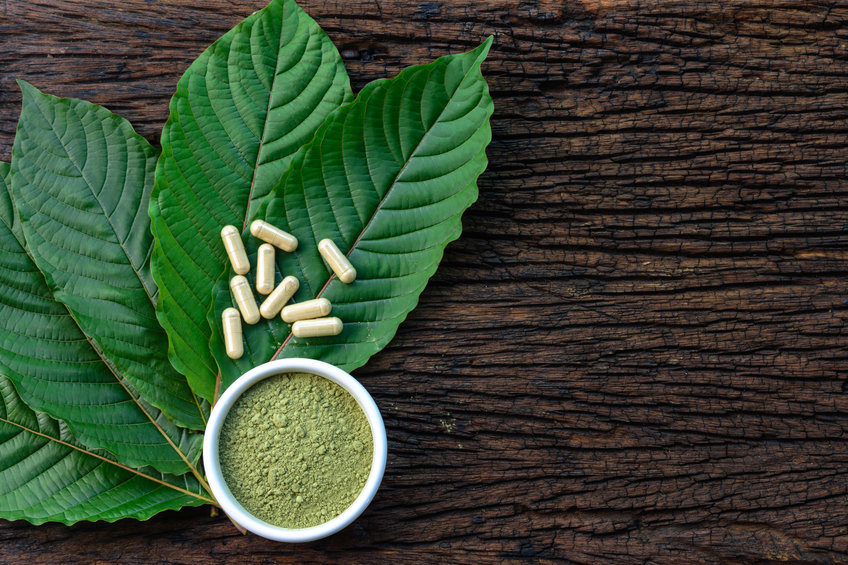
07 Jul Can You Develop A Kratom Addiction?
Kratom has grown in popularity in the U.S. in recent years and has been at the center of controversy about whether it is a drug with a dangerous potential for abuse, or an effective treatment for chronic pain. Keep reading to learn more about this drug and whether or not you can develop a kratom addiction.
Table of Contents:
What is kratom and how does it work?
Kratom originates from a type of evergreen tree related to coffee that is primarily found in Southeast Asia’s tropical regions. Its leaves can be used fresh or dried, and they are typically chewed or brewed into a tea. It’s also available in powder and tablet form, and it can also be smoked or used in incense.
Other names for kratom include:
- Ithang
- Biak
- Ketum
- Kakuam
- Thom
Kratom shares an alkaloid with opioids, which is known to interact with your brain chemistry. It is weaker than traditional opioids, approximately 1/10th as potent as morphine. Depending on the size of doses you take, kratom can have different effects.
In small doses (up to a few grams), kratom functions as a stimulant, producing effects such as:
- Increased energy, libido, and alertness
- Calmness, euphoria, and a sense of well-being
- More talkative, or increased desire to be social
At higher doses (10-25 grams), kratom functions more like the opioids we already know, with effects like:
- Relief from pain, depression, and/or anxiety
- Nausea, loss of appetite, and constipation
- Sensitivity to sunburn, itchiness, and sweating
- Insomnia, tremors, and hallucinations
What are the long-term effects of kratom?
The severity of long-term side effects can depend on a number of factors, including how much and how often kratom is used. Side effects reported after long-term use of kratom include:
- Lack of appetite
- Constipation
- Severe weight loss
- Insomnia
- Discoloration in cheeks
Can you develop a kratom addiction?
Kratom addiction is somewhat controversial, as kratom has been studied as an aid during opioid detox, but functions similarly as an opioid itself when high doses are consumed. Low doses have proven to be an effective alternative to traditional opioids in treating chronic pain, such as arthritis or fibromyalgia.
Some people may not develop an addiction to kratom at low doses. Other people may build a tolerance to kratom, meaning that they need to take increasingly larger doses in order to feel the effects, which can lead to addiction.
Can you overdose on kratom?
Most fatal cases of kratom overdose also involve other substances. But it is possible to overdose on kratom on its own.
Kratom overdose symptoms include:
- Fast heart rate and high blood pressure
- Nausea and drowsiness
- Agitation and irritability
- Seizures and coma
Is Kratom illegal? Does kratom show up on drug tests?
Kratom is illegal in 5 states, including Tennessee, Wisconsin, Indiana, Alabama, and Arkansas, and in several cities as well. Federally, it is legal, though noted as a “Drug of Concern” by the FDA.
Kratom does not usually show up on standard drug tests, as these typically only test for 5 drug types: amphetamines, cannabinoids, cocaine, opiates, and PCP. A kratom-specific test must be administered to determine if someone has taken the drug. Sometimes kratom causes false positives on opioid drug tests when combined with certain other supplements and medications, and it is occasionally mistaken for methadone.
Detection window for kratom
The average amount of time kratom will trigger a positive test result can vary greatly due to a number of factors, from the overall health of the person being tested to the method of consumption and how much was consumed. The average detection window of kratom tests is as follows:
Urine Test
5-14 days: This is the most common type of test for kratom.
Blood Test
3-72 hours: This test is not typically used due to its brief detection window.
Hair Follicle and Saliva tests
While these types of testing are theoretically possible, they have not been pursued nor extensively studied.
Kratom addiction withdrawals – what does detox look like?
Kratom withdrawal symptoms are similar to those of opiate and opioid withdrawal, though typically milder. Medically-managed detox usually makes for a safer and more comfortable experience, as doctors can evaluate your needs and put you on a safe and effective tapering schedule, gradually weaning you off kratom.
This method reduces the severity of withdrawal on your body, reducing the risk of long-term damage.
Kratom addiction withdrawal symptoms
Kratom withdrawal symptoms can begin as soon as 1-24 hours after your last dose, and can persist for 3-10 days.
- Severe stomach cramps, loss of appetite, diarrhea, nausea, and vomiting
- Runny nose and watery eyes, sweating, hot flashes, and fever
- Muscle aches, jerky movements, insomnia, seizures
- Dilated pupils, blurred vision, changes in heart rate and blood pressure
- Mood swings, irritability, depression, agitation, and anxiety
Elite Home Detox Can Help You Detox From Kratom Safely At Home
If you or a loved one is facing an addiction to kratom, you don’t have to give up your life for 30 days to go to a clinic. Our concierge mobile rehabilitation services bring addiction experts to you to design a rehabilitation plan that allows you to detox in the comfort and privacy of your own home.
During detox, one of our medical professionals will stay onsite 24/7 to monitor your progress and help make you more comfortable between your doctor’s check-ins. As you make aftercare and recovery arrangements, your designated care coordinator will help keep you and your health plan on track.
If you need help convincing a loved one to accept help, our trained Intervention Specialists can work with you and the rest of the support network to craft a message to motivate your loved one to begin the difficult journey of recovery. We’re ready to help – just call or click today!


